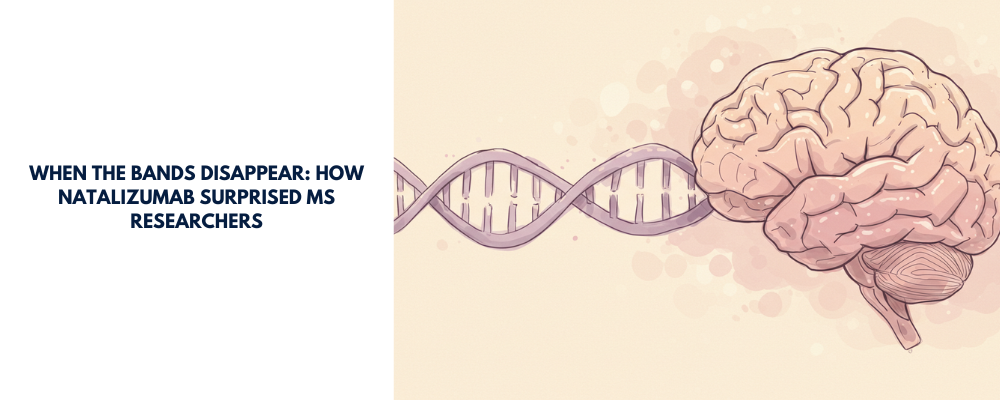
In the world of multiple sclerosis (MS) research, we’ve grown used to certain immunological markers being as reliable as old friends—always there, always the same. One of those markers is the presence of oligoclonal bands (OCBs) in cerebrospinal fluid (CSF). These bands represent immune activity within the brain and spinal cord, and once they appear in MS, they usually stay for life.
But what if a treatment could make them disappear?
That’s exactly the eyebrow-raising observation reported by Felipe von Glehn and colleagues in their 2012 Multiple Sclerosis Journal short report. The team described something never seen before in MS treatment studies: the disappearance of CSF OCBs in patients receiving natalizumab.
A Quick Refresher: What Are Oligoclonal Bands?
OCBs are patterns of immunoglobulin G (IgG) antibodies found when CSF is separated on a gel. In MS, they reflect local immune activation—B cells and plasma cells in the central nervous system (CNS) producing antibodies against a range of unidentified targets.
They are considered so stable that even aggressive treatments like immunosuppressants, autologous bone marrow transplants, or B-cell depletion with rituximab haven’t been shown to make them vanish.
Natalizumab: A Gatekeeper at the Brain’s Border
Natalizumab works by blocking α4-integrin, a molecule immune cells use to cross the blood–brain barrier. It’s like placing bouncers at the club door—T cells, B cells, and other immune actors can’t get in easily.
We already knew this reduces inflammation and MS relapses. But no one had looked at its effect on OCBs before.
The Study in a Nutshell
Participants: Six patients with relapsing–remitting MS (RRMS), all previously unresponsive to standard treatments.
Age range: 23–44 years.
Treatment: Natalizumab as second-line therapy.
Measurements: Lumbar puncture before treatment and after ~10 infusions to check OCB status.
The surprise: Four of the six patients no longer had detectable OCBs in their CSF after natalizumab treatment.
This was not associated with differences in relapse rate, disability score, or MRI activity between OCB-negative and OCB-persistent groups—but given the small sample size, it’s hard to draw clinical conclusions.
A Case That Raises More Questions
One patient (patient 5) offered an intriguing twist. While on natalizumab, his OCBs disappeared—then he developed progressive multifocal leukoencephalopathy (PML), a rare but serious brain infection linked to the JC virus. After plasma exchange to remove natalizumab, his OCBs returned, and his CSF tested negative for JC virus again.
Could OCBs represent a protective immune presence against certain infections? Or are they just bystanders? The authors note that MS patients often have antibodies against neurotropic viruses in their CSF, hinting at a possible protective role.
What Could Be Happening?
The authors speculate that natalizumab’s effect on OCBs may be due to reduced migration of T helper cells into the CNS, which in turn limits local B-cell activation and antibody production. Since B cells also express high levels of α4β1 integrin, their CNS entry could be directly impaired as well.
Interestingly, therapies directly targeting B cells, like rituximab, haven’t shown the same OCB disappearance—suggesting this effect might be specific to natalizumab’s mechanism.
Why This Matters (Even If We Don’t Fully Understand It Yet)
If natalizumab truly reduces or eliminates OCBs, this challenges the long-standing assumption that once OCBs appear in MS, they persist for life. This could:
Offer new insight into the immune cell interactions driving MS.
Provide a unique biomarker for tracking treatment effects.
Spark research into whether OCB changes predict clinical outcomes—or infection risk.
However, the study is small, and the clinical meaning of OCB disappearance is still a mystery. More research is needed before we can say whether losing OCBs is a good, bad, or neutral sign for patients.
Final Thoughts
Von Glehn and colleagues didn’t just report a quirky lab result—they opened a door to rethinking how the immune system behaves in MS under natalizumab. In a disease where some patterns seem unshakeable, seeing them shift is both scientifically thrilling and clinically humbling.
Disclaimer: This blog post is based on the information provided in the cited scientific article. It aims to provide an accessible summary of the research findings and should not be considered as definitive medical advice. For any health concerns, please consult with a qualified healthcare professional.
Reference:
von Glehn, F., Farias, A. S., de Oliveira, A. C. P., Damasceno, A., Longhini, A. L. F., Oliveira, E. C., ... & Brandao, C. O. (2012). Disappearance of cerebrospinal fluid oligoclonal bands after natalizumab treatment of multiple sclerosis patients. Multiple Sclerosis Journal, 18(7), 1038-1041.
